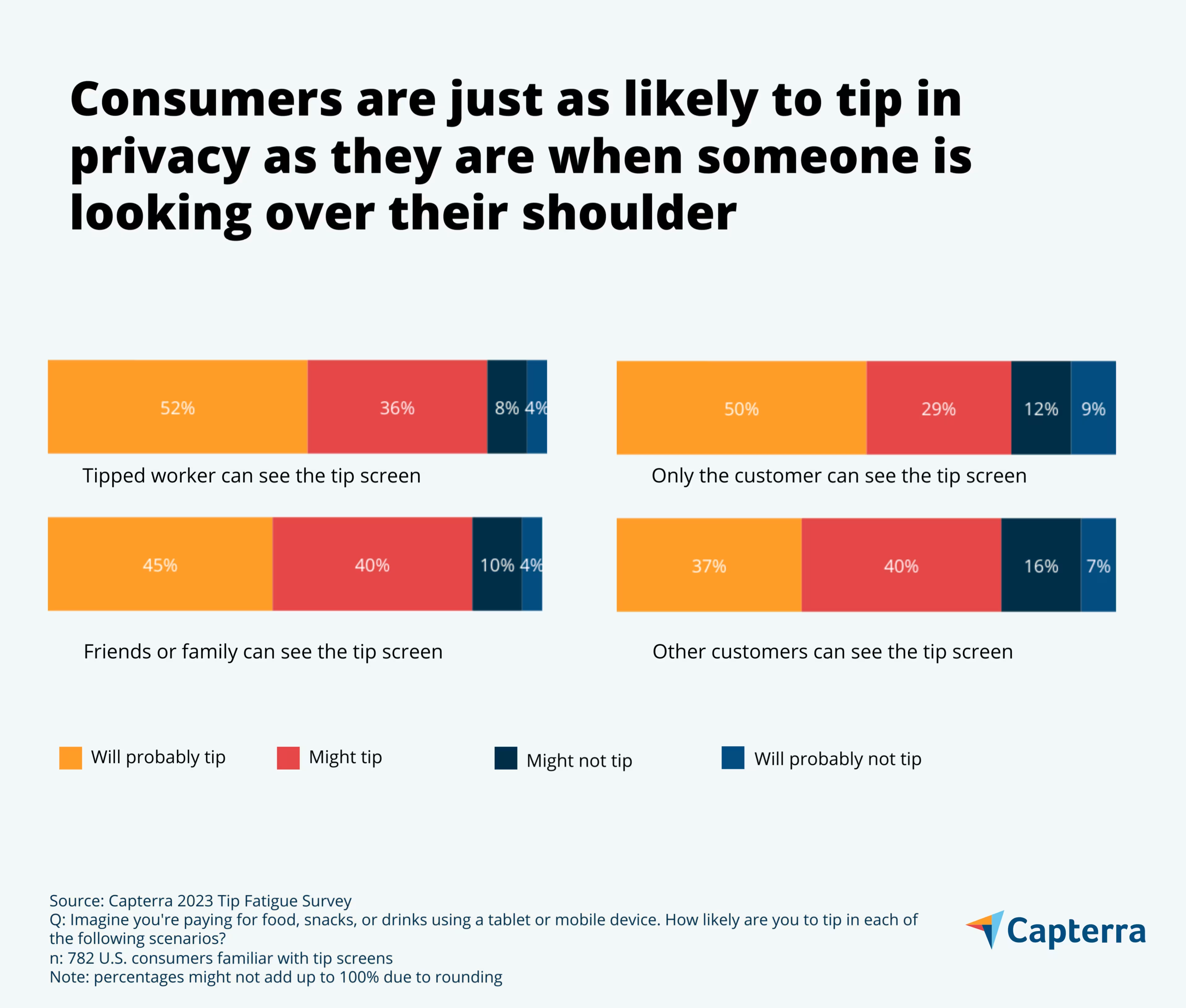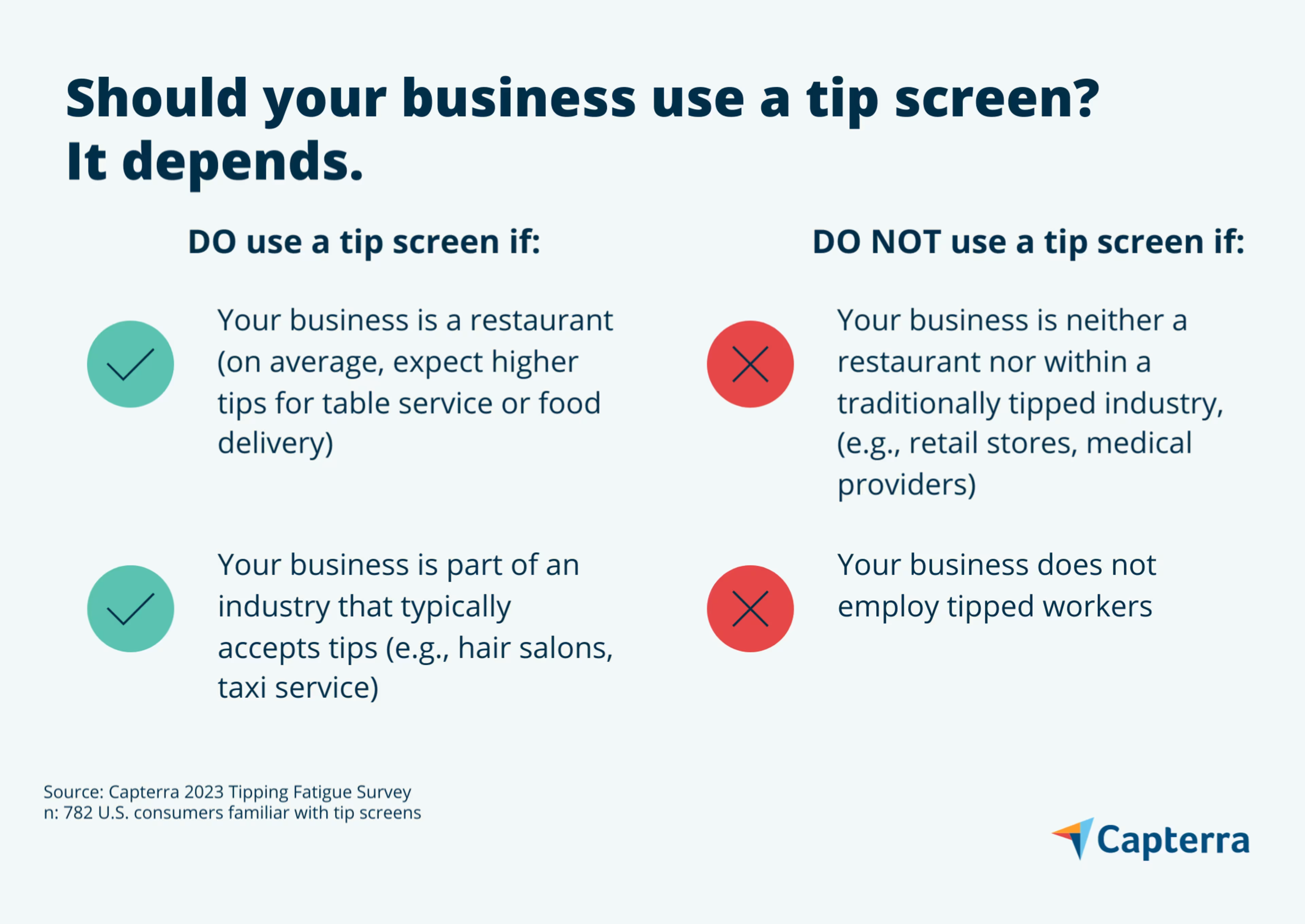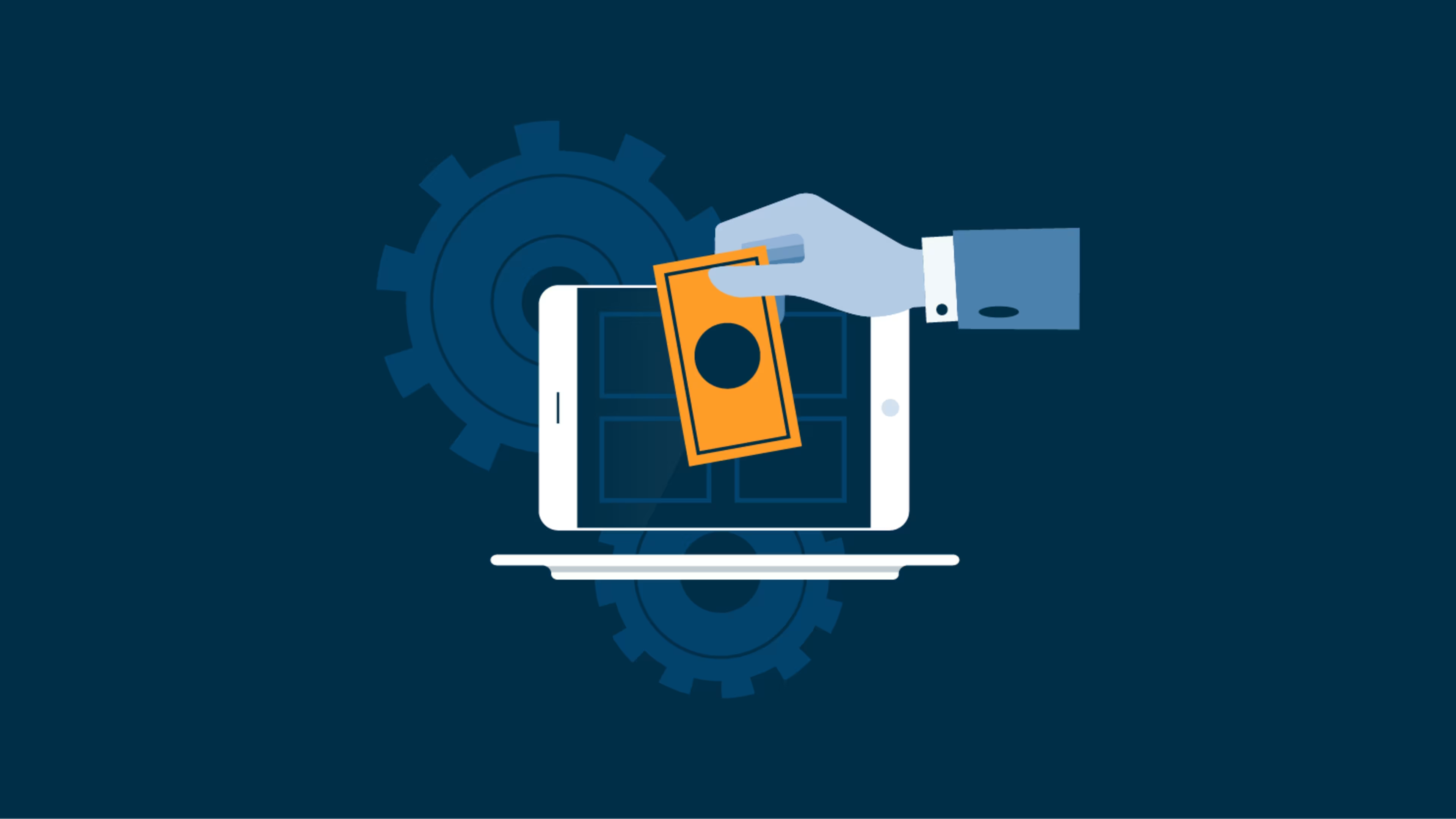Consumers are feeling bombarded with tip screens. Should businesses stop using them?
Consumers are fed up with being asked to leave a tip every time they buy something—which now includes not just food and drinks, but retail goods, gasoline, event tickets, and more.
Capterra’s 2023 survey of over 780 U.S. consumers who are familiar with tip screens on tablets or mobile devices found that half have felt manipulated or tricked into tipping when paying on a checkout tablet recently, and 70% say they’re being asked to tip too often.

Businesses need to reevaluate whether they should ask for tips, and how much to ask for, or risk driving away their most valuable customers—it turns out that those who are most fatigued by tipping are also those who tend to tip more money. Consumers are also still plagued with high inflation, so businesses need to act now.
With data-driven insights into how consumers’ tipping behavior has changed—as well as advice from a customer experience expert—small to midsize businesses can execute a profitable checkout strategy without contributing to tip fatigue.
/ Key insights
70% of surveyed consumers say they’re being asked for tips too often, a strong indicator of tip fatigue.
26% of surveyed consumers are tipping a higher percentage on checks now compared to last year, and 23% are tipping more frequently.
50% of surveyed consumers have felt manipulated into tipping on a checkout screen.
In the past year, 53% of surveyed consumers have encountered a tip screen at a business that didn’t previously ask for tips.
Consumers earning over $100,000 in household income are significantly more likely than lower earners to be impacted by tip fatigue.
Consumers feel tricked into tipping more often
About a quarter of consumers are tipping more at restaurants—either bigger percentages or with greater frequency—compared to last year. Even if they haven’t bumped up the amount they tip, the majority (70%) feel they’re being asked to tip too often.

Consumers tip to support frontline workers and their favorite restaurants, of course, and to reward great service. But there’s a more sinister reason for why consumers are parting with more money at checkout these days: One in two have felt manipulated or tricked into tipping while paying on a checkout tablet in the past year.
These negative feelings add up to tip fatigue, or the feeling of exhaustion from being asked to tip more money at a growing list of businesses. There are a few reasons why tip fatigue is such a big issue right now:
1. Tipflation
With customizable tip screens, businesses can set tip suggestions to whatever they want, regardless of whether customers find it appropriate. There’s a pervasive perception among consumers that businesses are leveraging tip screens to quietly raise the industry-standard tip percentage, chalking it up to inflation.[1] The majority of our surveyed consumers have seen the minimum suggested tip at restaurants rise over the past year (to 15%, most commonly).
While a minimum 15% tip may be reasonable for a table-service restaurant, most customers indicate that it’s too high for restaurants providing lower levels of service, such as fast food or takeout. For instance, while 82% of surveyed consumers have encountered tip screens at counter-service restaurants, just 43% are willing to tip counter-service workers at all.
2. Tip creepThese days, tip screens aren’t found just in the usual places, such as restaurants and hair salons—they’re creeping into new and unexpected venues, including retail stores. In the past year, over half of consumers have encountered a tip screen at a business that hadn’t previously asked for gratuity at checkout, leading to confusion and frustration. The majority have even seen tip screens at self-checkout kiosks (a third of whom felt pressured enough to leave a tip).
3. Tip screens remove the customer’s privacy
When using tip screens, customers often feel they have to make a quick and courteous decision while the worker they’re tipping watches their every move. The social pressure of having witnesses at the checkout counter strongly influences over half of customers to tip. Our data shows that, while the lack of privacy benefits businesses in the very short term, in the long term it damages customer experience.
It’s also not necessary to pressure customers into tipping—nearly the same amount of customers will tip if given a moment alone with the tip screen.

4. Opting out or customizing your tip is complicated
On many digital point-of-sale (POS) screens, the buttons to opt out of tipping or leave a custom tip appear smaller than the default tip suggestion buttons, making them easy to miss as you click through checkout screens.
Furthermore, if you choose to customize your tip to offer an amount that feels more appropriate, it takes extra steps to do so—while other people look on. Product design experts have called tip screens coercive insofar as they push customers to choose the path of least resistance–i.e., selecting a generous default tip rather than customizing or opting out.[1]
/ Key takeaway
The majority of consumers feel they’re being asked for tips too often, and, due to the tip screens’ inherent ambiguity (particularly at self-checkout), they admit that they don’t always know where their tip money is going. As more businesses jump on the tip screen trend, we can expect consumers’ frustration to build.
Wealthy customers are affected the most by tip fatigue
Business leaders beware: The wealthiest customers (who, according to this survey, are most likely to leave a hefty tip) feel the most upset over tipflation and tip creep.
Surveyed consumers earning over $100,000 in household income are 21% more likely than lower-earning customers to leave a tip of 20% or more. They are also significantly more likely to:
Have encountered tip creep
Have felt manipulated into tipping more on a screen
Say that they’re being asked to tip too often
Feel pressured to tip even after receiving poor service
Additionally, one in five wealthy consumers say they’ve been tipping too much lately.
/ Key takeaway
It’s tempting to use tip screens for your business, given the evidence that tip screens do lead to more tipping. But SMBs, particularly those outside of the restaurant or service industries, must balance their appetite for technology with their obligations to offer prices consistent with their level of service and preserve consumer trust.
Customer experience expert advises SMBs to scrutinize their tipping policy
To help businesses understand tip fatigue from the consumer perspective, we spoke with customer experience veteran Shep Hyken, who offered some advice for SMBs on when and how to ask for tips.[2]
“I think consumers sometimes feel guilted into leaving a tip, especially because of the way payment systems work today—it's easier than ever to ask for a tip.”


Shep Hyken
Customer service and experience expert
Know when it’s appropriate to ask for a tip
The consensus on which workers deserve a tip includes only a few: restaurant waiters and food delivery drivers. Support for tipping workers that provide high levels of hands-on service is so strong that 55% of surveyed consumers would support a mandatory gratuity charge at table-service restaurants. On the other hand, only 28% of consumers will tip for takeout, while 8% will tip at drive-thrus.
Per convention, consumers expect to tip some service workers outside of the restaurant industry, such as hairdressers or rideshare drivers. However, they do not want the list of tipped workers to expand to include, for instance, retail workers, automotive workers, or wellness-service providers, among many others. In general, if your industry at large has not historically accepted tips, don’t start now just because it’s convenient.
“If you were to add a tip to a checkout at a clothing boutique, you're going to raise eyebrows. If it's in a food service business where somebody's doing work for you, great. In a sales situation, it's different. They are taking care of me, but they're not waiting on me like a server would.”
Shep Hyken
If your restaurant provides anything short of full table service, consider starting your suggested tip range no higher than 10% to 15%.
Disable tips on self-checkout kiosks
People want to know who will receive their tip, and most are willing to tip more for excellent service. But with self-checkout, it’s not always clear to the consumer that a tip has been earned, let alone who might receive their tip.
A gray area is when restaurants use self-checkout kiosks. Most customers believe they’re off the hook for tipping in this case, since there wasn’t a worker helping them order and pay. But some may still want to tip the kitchen staff, so in this case it’s okay to include a tip screen at checkout. But you’ll need to make it clear where those tips are going, since the end recipient probably isn’t visible to the customer.
“If we get to a point where every business is asking for tips, it becomes normal. Nobody cares. But right now we are not quite—no pun intended—at that tipping point where tipping is accepted at non-traditional businesses.”
Shep Hyken
Let customers tip in peace
While it’s true that customers are most likely to add a tip when a worker can see the screen they’re using, feeling watched and potentially judged for how much you tip does not make for a great experience.
“[The tip screen] gives you a choice of how much you want to tip, you sign your name, and then you flip it back over for the employee to see what you left them, often before the food is even given to you.”
Shep Hyken
People are generally just as likely to tip when nobody’s watching, so it’s best to give customers some much-needed privacy at checkout when possible. That could mean asking your employees to simply turn away from the counter and start on another task while the customer checks out, or leaving the mobile checkout terminal with the customer for a few minutes while attending to other guests.
Provide great service
This point seems obvious, but with the pandemic-era decline in customer service quality, it deserves a mention.[3] Many customers tip regardless of the quality of service they receive. But don’t let that fool you—that social obligation to tip makes them feel cheated when service is bad. Businesses should prioritize excellent customer experiences, which they can achieve by investing in their employees with competent management, competitive pay, and thoughtful training.
“Did the employee create an experience that would make somebody want to give them 15%, 20%, 25%? If the people behind the counter are friendly, and they still help you, you might feel better about leaving a tip.”
Shep Hyken
Should your business ask for tips?
Adding a tip screen to your checkout tablet is one way to build revenue for your business. But it may not be a great idea, depending on the kind of business you run.
Use this quick guide to determine whether or how your business should use a tip screen:

55% of consumers tip to ensure workers are paid enough–are you doing enough to compensate your employees fairly?
If you’ve been thinking about hiring an expert to help you square away employee pay, you can browse our list of top payroll service providers. You can also learn more about how payroll service providers can help your business in Capterra’s hiring guide.
